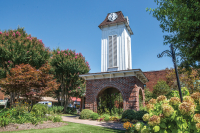Rare wood hunter unearths irresistible beauty in salvaged burl wood
 Stephen Metzger was like a kid in a candy shop as he clambered over a massive mound of behemoth tree trunks piled high in the wood salvage yard behind Moose Crossing, a woodworking studio on the outskirts of Waynesville.
Stephen Metzger was like a kid in a candy shop as he clambered over a massive mound of behemoth tree trunks piled high in the wood salvage yard behind Moose Crossing, a woodworking studio on the outskirts of Waynesville.
“Ashe, red oak, box elder, white oak, walnut, hard maple, sugar maple, sycamore,” Stephen said. “We’ve got a huge investment right here — huge.”
To the untrained eye, it’s nothing more than a jumbled, towering heap of tree trunks, akin to a monstrous game of pick-up sticks. But to Stephen, each one is a gem, with its own story to tell and a hidden beauty waiting to be unleashed.
The trunks of these weathered bark-clad giants are coated in lumpy, disfigured knots known as burls. Marvels of nature, the burled wood produces a coveted marbled grain secreted beneath the bark.
Slabs sliced from the salvaged trees will eventually be hand-crafted into high-end furniture pieces to be shipped all over the world.
Moose Crossing is a family-run business. Stephen is the procurement expert, scouring the country for rare burl wood to salvage, from the cypress swamps of Florida to the redwood forests of the West.
Related Items
His son, Daniel, serves as the chief designer and artist-in-residence. Daniel fashions the raw slabs into everything imaginable: dining room tables, mantles, conference tables, executive office desks, headboards, reception desks, bar counters, coffee tables, and even planters, chandeliers or his latest creation — a gong holder.

Last but not least, Stephen’s wife, Janet, serves as the main proprietor for Moose Crossing’s retail showroom in downtown Waynesville.
Each custom-made piece transcends the boundaries of art and nature, thanks to the keen eye and sixth sense Stephen has for scouting the signature burl wood.
“I can drive down the road and look at a tree from 30 to 40 feet away and tell if it has good graining. We know what we are looking for,” said Stephen, estimating he’s cut close to 30,000 slabs in his lifetime.
Each piece has an origin story — where it came from, how old it is, what led to its discovery — forging a bond between the owner and the wood beyond its sheer beauty. Despite the hundreds of slabs that have passed through Stephen’s stout hands, he knows them each on sight. The cypress ghost raised from a south Georgia swamp. A redwood cast off by early loggers because of its burls, which rendered it useless as lumber. An antebellum shade tree that once graced the front of a plantation home.
The rippled folds of the burled wood envelop the untold history of long-ago eras, a silent keeper to decades gone by. Wherever the signature slab pieces end up, their stories go with them, to be told and retold.
“We tell our buyers everything about it. They want to know the whole story behind it,” Stephen said. “When someone comes into their home and sees the piece, that’s the first thing they ask about and talk about.”
Among the more notable trunks queued up in the salvage yard: the sugar maples cut down from the front lawn of Haywood County’s historic courthouse three years ago. The county originally gave them to a charity that supplies firewood to the needy to heat their homes, but Stephen arranged a swap. He made a cash donation to the firewood charity in exchange for the trees.
When Janet escorts prospective buyers through the showroom floor of Moose Crossing’s storefront gallery in downtown Waynesville, she keeps a binder close by with the stories of the signature slabs, including photos of where the trees came from.
“They are just such amazing stories. I think people really appreciate rare, salvaged American wood,” Janet said.
Capturing the walk-in traffic from Main Street strollers has proved a critical link in reaching customers.
“It’s crucial,” Daniel said.
Some buyers encounter Moose Crossing’s work at furniture shows and art fairs, and others find them online. But a large number are tourists or second-home owners who stumbled into the downtown showroom.
“When people walk in, their jaw drops and they say ‘Wow … wow,’” Janet said. “They had no idea they were going to be buying a $5,000 table that day. They are just captivated by the organic beauty of the wood.”
A gift from nature
Inside the workshop, Stephen darted among a sprawling maze of stumps and slabs, pointing out his favorites with the affection of a doting father.
“These are special. Look at these right here, a 12-foot tall burl,” Stephen said, running his hand over the swirled grain. Swinging wide past his son who was rubbing down slabs with coats of tung oil, Stephen pivoted toward another stack.
“These are special slabs, see all the burls?” he said.

Stephens steered his way through the workshop to the cutting yard for a gander at his main project of the week: stripping long slabs off a 350-year-old red oak he hauled up from Georgia. It’s been a painstaking task. Sundry items had been tacked to the tree over the centuries and then buried from sight as the wood grew around them.
“I’m hitting nails, I’m hitting horseshoes, I’m hitting fences,” Stephen said. “You never know what you are going to run into.”
A sapling when Ben Franklin was born, the tree had finally succumbed to old age, but was too knotted and too thick to be felled. The owner set fire to it hoping to burn it down, but merely toppled it. A neighbor who saw the burled trunk, laying charred and splayed on the ground, tipped the man off that it could be valuable. Some online sleuthing led him to Stephen, who made a road trip to survey it.
While the trees Stephen procures are usually unwanted, he forks over top dollar nonetheless once the owner of a tree realizes he has something of value on his hands.
“There is no free lunch,” Stephen said.
High-quality burl wood can run $5 a pound. A large trunk can clock in at 10,000 pounds, so “you have to put out $50,000 before you even cut it.”
Each tree Stephen acquires carries a costly upfront investment. Finding the rare and unique trees is only the first step in a long and laborious journey from raw wood to a finished piece.
Extracting the titans from the forests and farms where they’ve been quietly molding their coveted burls for a century or two or longer is a monumental undertaking.
“We use cranes and skids and bulldozers and big forklifts. All this is part of the process,” Stephen said. “A lot of people think it just falls off the back of a pick-up truck and we pick it up.”
While some of Stephen’s finds come in as cold calls, other times he goes on expeditions in search of wood.
After finding the wood and negotiating a price, the extraction can take days, lining up equipment and hiring local laborers to cut and haul out the trunks. Then he still has to ship them back home on a rented semi.
Once they arrive at his Waynesville workshop, the real work begins. The trees are cut in long slabs and dried in a low-heat kiln for months, then carved, sanded, polished and rubbed with a few dozen coats of Tung oil to bring out the wood’s natural luster.
At last, they can be fashioned into a final form.
Daniel, who is a vested partner in the business, lets his creativity lead the way as he checks out spec pieces that are sold online, at trade shows and in the downtown gallery, but also works directly with clients who have a vision for what they want and hand pick the slab for their piece.
“When people walk in, they are kind of dumbfounded for a minute,” Daniel said.
But Daniel guides them through the process until they find the right match. Daniel pointed to a collection of pieces with sold tags at the front of the workshop waiting to be crated and shipped out. A couple from Florida wandered into the downtown gallery while vacationing in Waynesville and they were mesmerized with the majestic burl wood. They commissioned two bedside tables for their home, and a coffee table and cypress stump planter for their real estate office.
The quantity of wood stockpiled in Moose Crossing’s workshop and an off-site warehouse — where pile after pile of cut slabs are stacked two-stories high — is dizzying. They have thousands in all, making them the largest dealer of salvaged, rare burl wood in the South. Stephen never turns down a tree if it’s got potential.
 “There’s no such thing as too much wood,” Stephen said.
“There’s no such thing as too much wood,” Stephen said.
“Not until we run out of room,” Daniel added.
Stephen got his start in the rare and salvaged wood business in the early 1970s in San Francisco, with a gallery storefront there for more than a dozen years. He sold the business and moved to Waynesville in the mid-1980s to be near his parents — who had retired to Waynesville — after his father got Parkinson’s.
When Stephen first landed in Waynesville, he dabbled as a developer. Over the next 15 years, the Metzgers led several lives. Their rich and varied resume included a stint in the Colorado ski industry, a start-up bungee jumping operation in Cherokee, a water sports business in Panama City and an eco-tourism outfitter in the Florida Keys.
But they were pulled back to Waynesville, settling here for good in the late 1990s. For several years, they ran an antique and auction business, but in 2007, Stephen returned to his roots as a rare and salvaged wood dealer.
It seems like a bold move in hindsight. The recession was in full-throttle, arguably not the best timing for a venture plying high-end, upscale furniture.
But Stephen found untapped demand for the quality craftsmanship and raw beauty of burl wood pieces..
“This is one product that is actually going up in value. The salvaged wood is getting rarer and rarer and harder to find,” Stephen said.









